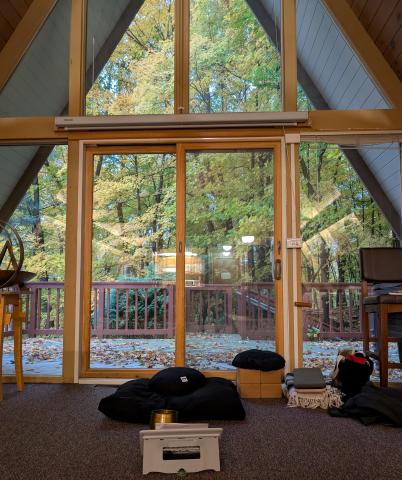A memorable moment on the floor
I have forgotten countless moments from graduate school, which I started more than 25 years ago, but one experience has stayed with me. One evening I walked into a clinic for group therapy. My therapist had suggested it, along with medication (that was not helpful). I felt tired and a little curious. The room held a circle of chairs. The fluorescent lights felt a bit harsh. The therapist told us we could sit up or lie down. Lying on the floor felt like the obvious choice.
He guided us through a simple body scan. I remember feeling amazed that he could name a body part, such as my toes or forearm, and suddenly I could feel a slight tingling there. It felt like discovering a part of myself that had been on mute.
After the practice, we shared our reactions. I remember feeling uneasy, unsure how I fit in. Some people in that clinical setting were experiencing problems that felt much more severe than mine. That discomfort came from fear, and it kept me from returning. Looking back, I missed out. Many of us pull away from support when we feel like we don’t belong. I stayed away for many years.
Decades later I learned the phrase that describes what I felt: interoceptive awareness. It refers to our ability to notice internal signals such as heartbeat, breath, or tension. This awareness helps us regulate stress and emotions. It lets us notice pressure before it overwhelms us. Research on body scans is plentiful, and you can browse some of it by searching for body scan meditation.
That moment in the clinic shaped my life. Today, I work to create spaces where people feel safe enough to stay. A room where you can lie down without judgment. A room where you can notice your own breathing without rushing. I am not a medical professional. I don’t offer therapy. I just know what helped me find steadiness.
Why the body can feel distant
It is easy to drift away from our bodies. Long work days. Busy family schedules. Constant screens. Stress quietly piles up. We get numb. We move from task to task without pausing. The body becomes something we ignore until discomfort demands attention.
A body scan offers a different path. Instead of pushing through tension, you slow down. You listen. You meet sensation with curiosity.
The science of slowing down
Research on body scans shows meaningful results for stress reduction and emotional regulation. People who practice them often report better sleep and less reactivity. There is even a study suggesting that practicing a body scan with a dog nearby increases feelings of connection.
It can be tempting to read the research and stop there. But reading about meditation without practicing it is like reading about playing the piano without ever touching the keys. The benefits unfold through experience.
A simple way to begin
Sit or lie down. Take a slow breath. Bring attention to your feet. Notice sensation, such as warmth, tingling, or pressure. Then move up your legs. Hips. Stomach. Chest. Hands. Arms. Shoulders. Jaw. Face. Head.
Your mind might wander. That is normal. Gently bring it back without judgment. It’s not a performance. It’s a conversation with your own awareness.
What you might notice
You can’t really predict what you will feel before you practice. Tightness. A pulse. Calm. Restlessness. Drifting thoughts. Waves of emotion. Some feelings surprise people. Others feel dull, like static. It all belongs.
This noticing reveals how the body carries stress. It shows where you brace against life. Over time, the body scan becomes less about scanning and more about listening.
Community matters
Last week our Tuesday meditation group gathered at Lake Fellowship (pictured above). We had a wonderful turnout, and practiced the Kripalu technique of BRFWA: Breathe, Relax, Feel, Watch, Allow. A few people shared that the practice touched them deeply. That kind of connection matters. Small rooms with shared attention can do something special, and several people have told me they’ve started a daily meditation practice because of it.
This week we will explore the body scan. We’ll discuss what the science points to, but the practice matters more.
If you can’t make it, you can search online for “body scan meditation” or listen to one of mine from Pretty Good Meditation. You’ll still benefit. What you’ll miss is hearing how others experienced it, and perhaps insights you might not find alone. You might, however, have the benefit of a dog nearby, one we won’t have at Lake Fellowship.
Take one small step
Whether you join us on Tuesday or not, you might try a body scan once this week. Keep it simple. Notice sensation without forcing anything. You might feel softer. You might feel more present. You might even feel surprised, like I did in that clinic 25 years ago.

Comments